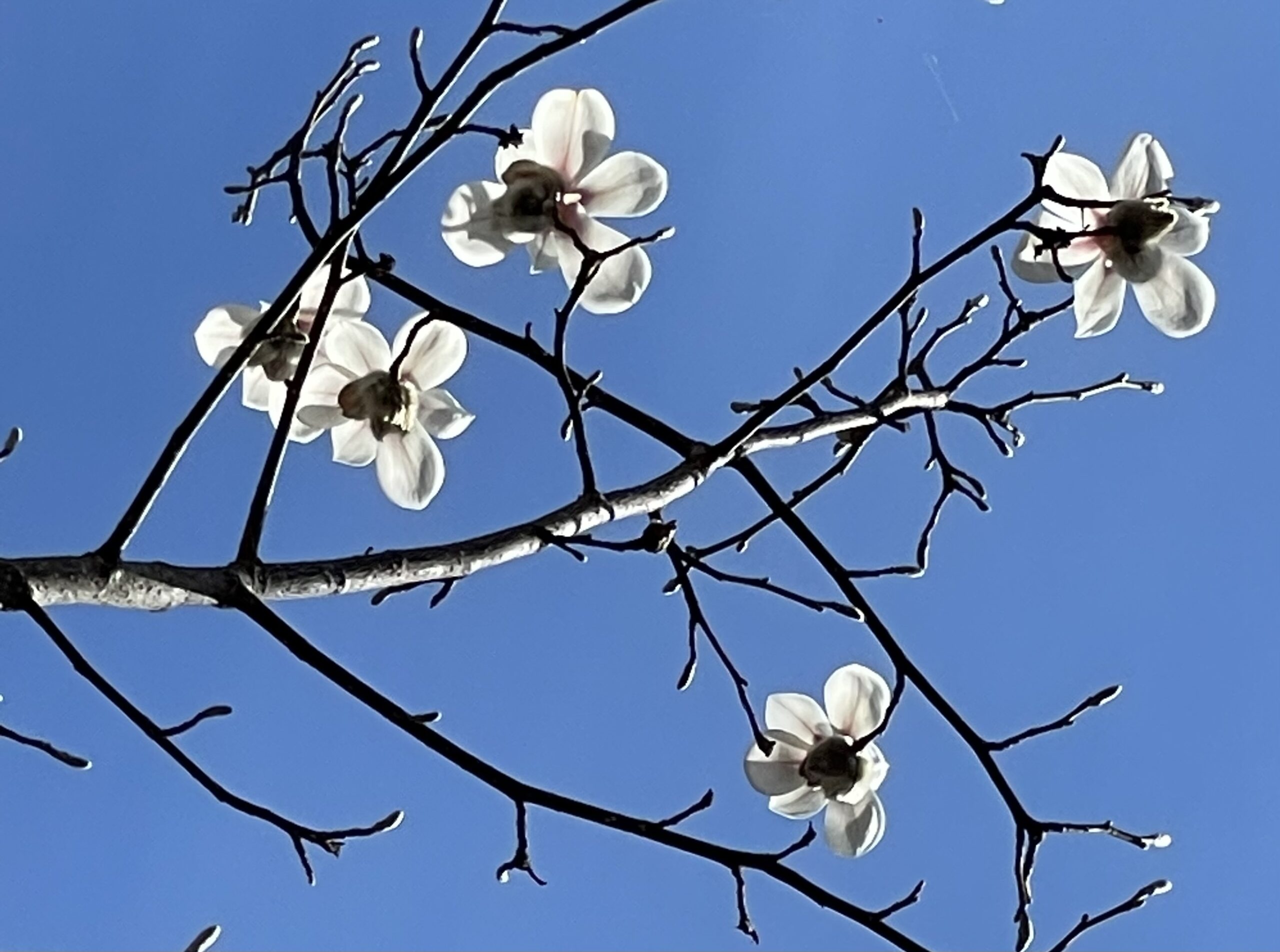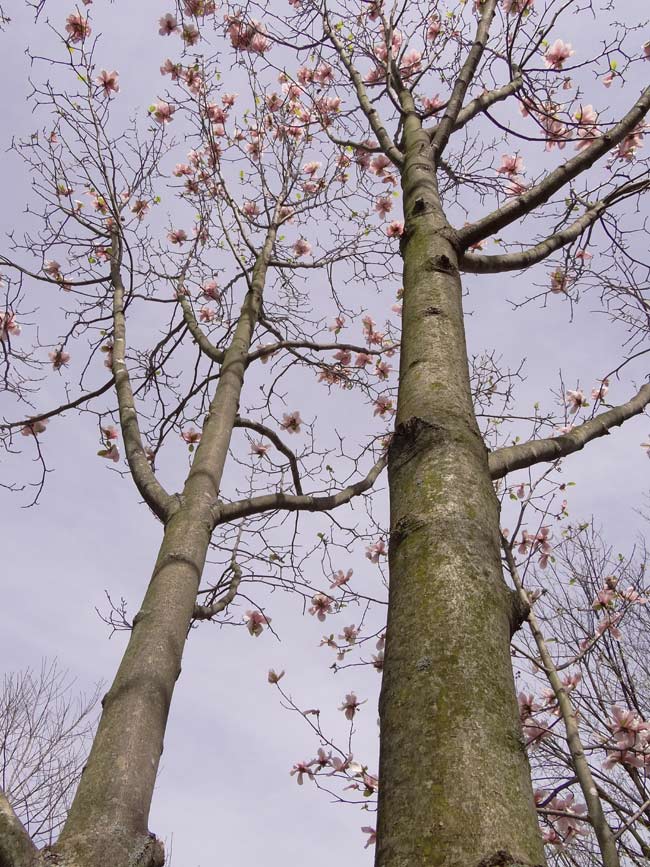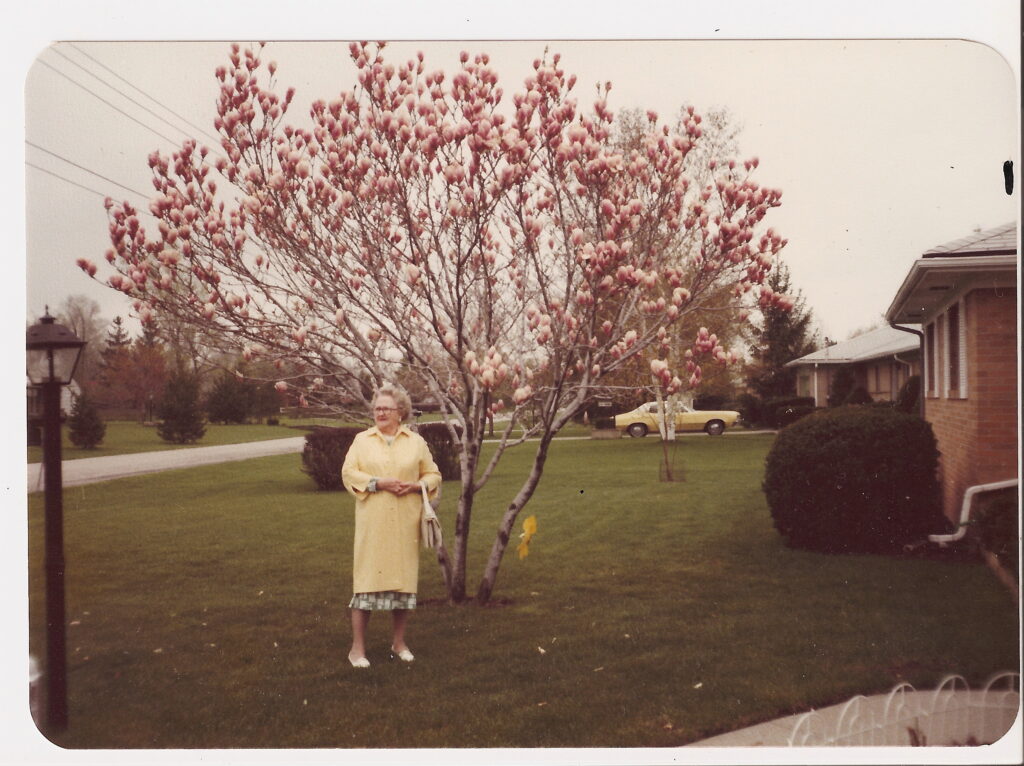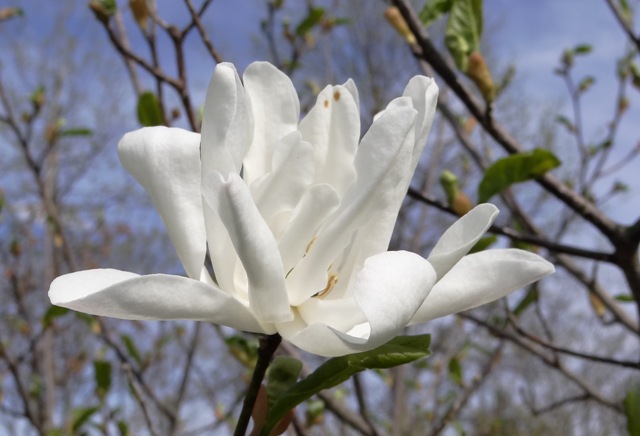Experience-Seeds-Knowledge-Plant Discoveries-Ecological Enrichment-Join Now Click Here!


Bird Cherry Meets Dingle Dangle Meets Wild Magnolia

Every plant has its limitations. As gardeners we soon discover how that translates in our own experience with certain plants and how something will grow or not grow in our own landscapes. Here are a few of my personal discoveries of which each is related in some way. Each species has a place on my farm as well as a place in my thinking on how nature functions. I learned so much from them only to find out they share many commonalities in the real worlds of ecology and plant physiology.
The Dingle Dangle Berry-Hearts a Burstin Tree – Euonymus europaeus
I began growing this tree from seeds that came from several arboretum collections. I thought it would be interesting to develop new varieties from it while finding faster growing and taller specimens. It was little grown in North America and had a beautiful winter display of red fruit that the birds consumed with great gusto. From this particular species you can then root it and make it available as a cultivar in the nursery industry. I was happy to see quite a bit of variation in the progeny so I planted out the seedlings that looked like crosses with another well known Euonymus, burning bush. I made one small row of twenty of the best plants where they grew in the shade of my American persimmons and northern pecans. Not long after they started to fruit a scale insect encrusted the bark of the trees and sucked the life right out of them. They became weak and heavily infested with a spider mite right after that. At that point I got out my saw and saved the larger trunks and straight stem pieces for making what I was calling my future art project. “Say goodbye to that idea” I thought referring to my nursery goals as I cut them to the ground. The scale was super powerful and it was amazing how fast it destroyed my lovely plants that I nurtured for over a decade. It was a loss but I soon found out it was a good loss. Think about this for a moment. If that insect had never come, the plants would have never flourished in the real world. They would only survive if it had been sprayed or if luck would have it, isolated in some fortunate way to miss the bug. As time went on, I began to see new seedling trees emerge and a couple of the original plants seem to have some resistance. The scale is still found but now a new generation is skipping by this rather dramatic event leveling whole populations of my Hearts-A-Burstin trees. It does appear the scale has less of an effect despite its presence. The plant is saying to me, “yeah so what. I’ve seen worst”. In the meantime, I will watch the birds consume the fruit and benefit from its presence. To a certain degree I too will benefit when eventually I can make art from the demise of its earlier incarnations and enjoy a new generation of trees from this little appreciated tree.
The Bird Cherry Meets the Inevitable Black Knot-Prunus padus
I first found out about this species from a nursery person from Montana, the late Clayton Berg. I never knew him personally but was able to communicate through a family member once in a while. He was very cool in my books. Lawyer Nursery in Plains knew about him and his species selections in the coldest parts of that state. He had a nice collection of both the bird cherry and the chokecherry. If you look at both of these species growing side by side, you will see a lot of similarities and easily get confused on a taxonomic level. It was amazing to me how something a continent away had so many characteristics to a plant indigenous to North America. At one point, I did sell Prunus padus in my nursery too. It was very vigorous and healthy growing and included several purple leaf types. I noticed in growing the progeny several unique variations and I planted these out as soon as I could. The trees grew fast and fruited quick. The large green leaf forms were super vigorous and healthy. I selected the fastest growing green leaf forms for its tree like growth habit and the purple leaf forms for their dark purple and black leaves. It was one of my first from seed unique selections. I remember what a joy it was to collect the fruit in the farthest hillside of my farm. At that time there was few plants established on this windswept hill. The fruit was impossible to eat fresh off the tree. One pea-sized cherry in your mouth was all you could take. It was even more astringent and drier tasting than the chokecherry. One fruit in your mouth would render all other flavors neutral. I had heard you could make jelly out it. Sugar was the solution. I was hoping to try but I never got the chance. As time went on, black knot found its way to these plants in the middle of my field. Wind brought it in. There is all sorts of things transported via wind and spores are light. It was not pretty. Like flames off a burning pile of tires, the dark bark disease engulfed the green leaf forms to the point that even the main trunk was consumed. There was a small pile of sawdust left after the borers dove into the weakened trees. “Wrap it up” the borers told me. Bird cherry was super prone to this disease. Even today the seedlings that persist under my mature chestnuts have large amounts of black knot on them where they rarely reach six inches tall. The purple leaf forms hung on with no black knot for about a decade after the carnage of the green ones. The resistance was short lived and one by one the purple leaf types crashed. Borers did their usual clean up in aisle Prunus. In the meantime, I had expanded the chokecherries that I also received from Clayton Berg and those grew very well. There was one seedling planting I made with a form of purple leaf chokecherry that I found at my old bank next to the parking lot. I grew those from seeds and even today they are spectacular in leaf color, very fruitful and healthy. As to be expected, I saved a few bird cherry trunks for my growing and now future ambitious cool art project that I knew I was going to do one day.
Wild Magnolias Have a Mission Statement
There is a lot of species Magnolias found throughout the world. I only saw two in the landscape. Why so little? For a while I belonged to the Magnolia Society. They had a seed purchase and exchange system in place where you could send seed into the Counter and they would put up small packets which would then raise money for the organization. I grew many of these species types and their natural hybrids from this exchange and purchase. I began looking out for the odd shaped fruits in the fall on magnolias in my area. Since I did not have mature trees at my farm yet, I found a public arboretum that would allow me to collect. I found a couple of private yards where the owners said “Knock yourself out” because they viewed them as a problem that needed to be raked up and thrown away. These different species and hybrids of seeds allowed me to try growing new types of Magnolias at my farm both for selection as a timber like tree and the great flower displays that is loved by all. I was not interested in creating varieties from it to any degree but instead discover the value of the species under cultivation. Frankly, I just liked the flowers. My grandmother loved her magnolia too. It was in my blood.

The first thing I soon found out was how sensitive many of the wild species were to drought. The issue was that if the moist loamy acidic soils of their native haunts were not matched up precisely then you are digging holes for giggles. It did not matter which continent the plant was found on. What mattered was the amount of rain fall and the rich organic laden soil which would hold this precious resource in between rain fall. I had purchased several nice Magnolia books which told the story of each species and where they grew most abundantly. Usually people who love Magnolias hybridize species to get a more forgiving selection to soils and cultivation. The Magnolia genus is highly sensitive to water. The roots of the magnolia look like succulent spaghetti like strings emanating outwards from the central stem. Magnolia is not messing around trying to capture that resource. I remember when we grew them in the greenhouse they would grow straight through the webbed trays onto the weed mat only to create their spreading root mass all entwined with one another in a dense mat. On the mat they could suck up water in great quantity the same way a willow does near a stream. They loved the polyhouses. Why wouldn’t they? Regular watering, high air humidity and rich organic soil media was perfect conditions I created for them. Going from that to the outside was a bit of a shock. In the real world of drought, sandy soil and low organic matter it might be too much to ask when the wind starts blowing and your trees becomes brittle stems of their former glory. This happened a lot before I finally got the message.
Despite these ecological limitations, many species including the hybrid crosses with the most vigor began making good headway at my farm. Other chestnut, walnut, oak and hickory trees nearby were blocking and slowing the wind speeds, creating humid air and soil conditions while my tree crop forest was taking shape. The Magnolias followed this line of action very effortlessly. To me this shows that as a component of a forest, the magnolia can easily establish in these locations. I had several crosses mixed with my bur oak hybrids and chestnuts. Magnolia was not some sort of magical pioneer species. The wild selections of the cucumber magnolia, Magnolia acuminata were probably the most prone to drought and very weak growing. I found a large diameter species near a lake front home in a nearby town which thrived in this high water table area.
In one particular area of my farm, I used a west facing slope where the soil was extremely thin with little organic matter. It was very windy there. I started growing many seedlings of what is known as Magnolia loebneri.

Loebners magnolia is not usually grown from seed but as luck would have it, I found one plant with massive amounts of fruits and grew thousands of seedlings of it. It was a hybrid cross from the Star and Saucer magnolias discovered as an accidental garden hybrid. It had a bit of mountain ruggedness of the star magnolia added to the rather delicate and early flowering Saucer magnolia. I planted them in an area that is best described as anti-Magnolia. I used seedlings that showed the greatest vigor and hauled them out of their polyhouses in late summer while the two of us, one a navy veteran, chiseled the holes in the rocky and sandy ground. We put sawdust around the roots, watered them in and added small two foot tubex tree shelters on them. After that they were left alone on the hill to experience life in grape country. It was not pretty and I did loose about a third of them in the process. It turned out that the selection process of vigorous trees including the forms with lots of small branching was a good choice even for this extreme area. This structure type and the rather dwarf nature and vigorous growth made it possible for the plants to flourish in the anti-magnolia areas. Most if not all of the other species I tried were having problems. In the meantime I started to limb the Loebner trees upward creating a single trunk. I did cheat a little by dropping off some composted cow manure once and using mulch mats. That did not help to any degree. During this time, I noticed that these selections in particular had hairy leaves and produced lots of shade from the dense branching to protect their root zones. It was like the whole thing was orchestrated way beyond my control. I no longer added anything to this planting and now began to harvest seeds from this location almost every year. There is no grass underneath the trees now too. That disappeared with shade. Shade is the ultimate herbicide. In this case loosing the grass was of benefit to the Magnolias by creating a sort of hyperspace for magnolia roots which would then create a web of interlocking roots to retrieve moisture from my sand dune area. Even a little water is absorbed by the Magnolias in this area. The other day I tried to dig down in one of these areas and it is essentially impossible as the roots have encased the soil so completely it is just like the polyhouses. You would have trouble putting in a teeny 2 inch plug and it would not likely survive long. The magnolias own that real estate at this time. You can’t even rent.
That being said I did save several of the wood pieces for a future art display of great magnitude which is currently stored safely in the upper portions of my barn. A portion of the ideas to do this are safely stored in certain neural regions of my brain as a back up. It will be a great art display of something of which I know nothing.
The Take Away
The take away from selecting plants or defining varieties or using seeds for human intentions, highlights the functionable aspect of the stem and leaves of the plant and its ability to resist forces at the junction points of air, water and soil. It is a kind of a tension and compression sort of thing. We may think ‘oh this is a flop’ and not really look closely at what happened and why. We may just see it as a dead plant and move on. In the case of bird cherry and the dingle dangle tree, it is the stem of the plant and its power to provide nutrition to its leaves from the roots. This ability needs to be enhanced by the use of disease as a sort of motivator or means for change in this real world scenario. Without that energetic motivator, nothing would happen and likely a cascade of events would occur slowly taking it back and reversing its evolutionary trajectory.
It is this sort of change that is needed on a functional level that disease provides for plants. Not pretty and never desired by gardeners, we arrest that in our realms. On the Magnolia, a disease is not needed to overcome a certain set of environmental conditions. It is more like an extension of its existence outside of its confines to new locations in soils completely foreign to it. How does it do that? With an attractive and fragrant blossom, humans are extremely attached to it and humans are good movers. We will move that and keep growing it. Because the magnolia has the attention of the number one mover and shaker in the world, the human being, it could travel quite some distance in a short period of time. The seeds of magnolia dangle too. It is a string falling from the seed pod. What could be more available than a seed dangling from a seed pod high in a tree? The Dingle dangle knows this. The chokecherry knows this too and has large long clusters that hang down on the outside of the tree. You can’t miss that and neither can the birds. The whole system is set up to capture our attention with fragrance, taste and nutrition. We are only slightly intercepting that trajectory of movement. We might harvest the fruit for food. We might use the plant as an ornament in the winter. We may enjoy the plant the most in the spring. It is these characteristics we are harnessing. We may cut down the tree for wood. We may find medicinal properties in the fruits and leaves. And at some point in time, in the far future we may create art with it too. You never know. In each way, the plants are part of our life.